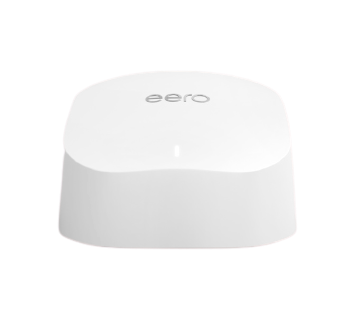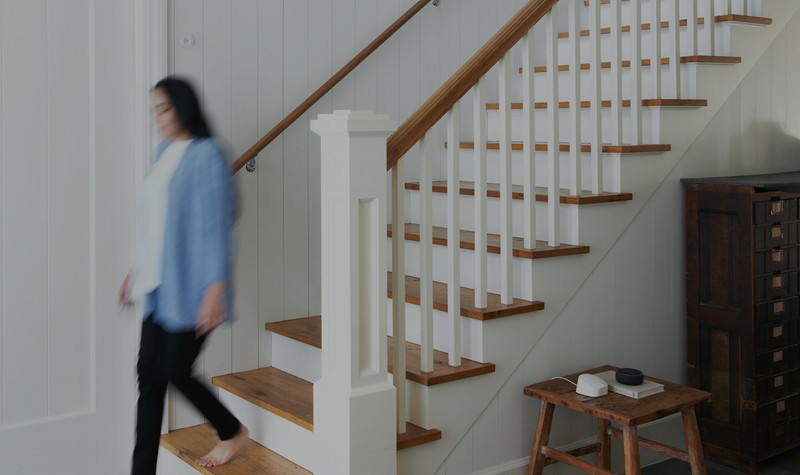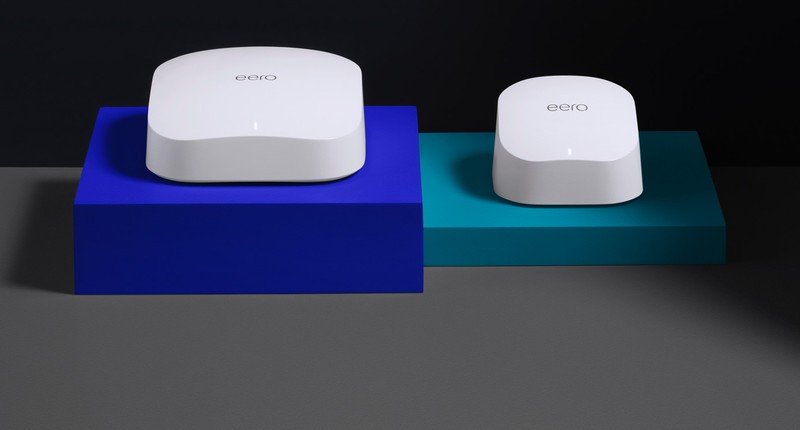Starter Wi-Fi 6
Eero 6
Pros
- Wi-Fi 6 increases mesh performance
- AX1800 delivers enough speed for more people
- Compatible with all existing Eeros
Cons
- Dual-band Wi-Fi is worse for mesh performance
- Only one open Ethernet port on the base router
Eero 6 is a solid upgrade to the base Eero line. It brings with it Wi-Fi 6, which takes the 5GHz performance up to 1200Mbps with compatible devices. Even if you haven’t upgraded your wireless devices to take advantage of Wi-Fi 6, it ensures a faster connection between the different routers in your mesh.
Gigabit speed mesh
Eero Pro 6
Pros
- Wi-Fi 6 tri-band delivers gigabit speed
- Compatible with all existing Eeros
- Dedicated backhaul keeps mesh speed high
Cons
- More expensive
- Only one open Ethernet port on the base router
Eero 6 Pro has all of the best features Eero 6 has with a little more of everything. A tri-band connection allows the mesh to hit gigabit speeds with an extra 5GHz band. Dual gigabit Ethernet ports on each router allow you to connect wired devices to a node without giving up speed, even with a fast connection.
The main difference between these two routers is the top speed, with the Eero Pro 6 delivering speeds above 1Gbps with ease even while connected to a remote node. While a single Eero 6 router supports a gigabit connection on its own, you’ll be sharing your 5GHz band, splitting your 1200Mbps speed if you add in more nodes. This allows for speeds up to 500Mbps with a little headroom, which is more than enough for most people.
Eero Pro 6 vs. Eero 6: Do you need another band?
If you deploy either of these routers alone, the speed you get will be basically identical, with most Wi-Fi 6 devices maxing out at 1200Mbps. If you only need one in an open space of less than 1,500 square feet, there’s very little reason to upgrade to the Eero Pro 6. While an Eero can be a great standalone router in a small space, they’re designed to work together.
If you deploy two or more Eeros in your home, Eero Pro 6’s extra 5GHz band will keep transmission speeds over 1Gbps with ease. All of the nodes in your mesh will need to communicate with each other to work.
With only a single 5GHz band, Eero 6 must share that connection with wireless devices and communication to the Eero connected to your modem. This essentially cuts the 1200Mbps best-case scenario speed in half leading to Eero’s recommendation for 500Mbps. This is similar to our testing of the Wi-Fi 5 Eero that had speeds around 400Mbps or right around half of its 867Mbps 5GHz band speed.
Luckily, Eero 6 and Eero 6 Pro have been updated with support for Dynamic Frequency Selection (DFS) which opens up more 5GHz bands so the nodes can avoid interference a bit better than using the standard 5GHz modes. This does not need to be configured by the user and will be selected automatically by the Eero software if necessary.
| Eero 6 | Eero 6 Pro | |
|---|---|---|
| Wi-Fi | Wi-Fi 6 dual-band | Wi-Fi 6 tri-band |
| Wireless speed | AX1800 600Mbps at 2.4GHz, 1200Mbps at 5GHz |
AX4200 600Mbps at 2.4GHz, 1200Mbps at 5GHz, 2400Mbps at 5GHz |
| Spatial streams | 4 | 8 |
| Channel width | 20, 40, 80 MHz | 20, 40, 80 MHz |
| Ethernet | 2 | 2 |
| Coverage (single) | 1,500 sq. ft. | 2,000 sq. ft. |
| Dimensions | 3.91 x 3.82 x 2.42 inches | 5.3 x 5.3 x 2.1 inches |
Eero Pro 6 vs. Eero 6: Software
Eero Pro 6 and Eero 6 are both set up and managed with the Eero app. This app will guide you through the setup process and allow you to configure your wireless settings. You will also be able to inspect the quality of your mesh link and see which devices are connected. Included with the Eero app are Eero Secure and Eero Secure+. These subscriptions can add security to your connection with real-time antivirus protection as well as helpful software like a password manager and a VPN. The base Eero Secure plan is $2.99 per month or $29 per year, while Eero Secure+ is $9.99 per month or $99 per year.
Recently, Eero has added a new feature to its Eero Secure+ tier called DDNS. This feature, accessible through the Eero app on mobile, allows you to create a secure connection to your home network even when you’re on the go. This can allow easy access to devices on your home network and can be great for saving room in your travel bag if you don’t want to travel with portable hard drives.
For your smart home, Eero 6 and Eero Pro 6 both include a Zigbee smart home hub. If you have compatible smart home devices, this can simplify your network. Eero also includes support for Alexa, which is unsurprising considering Amazon owns Eero.
Finally, Eero 6 and Eero Pro 6 also both fully support HomeKit. This means that smart homes using Apple’s HomeKit and an Eero 6 or Pro 6 get greater security for their HomeKit accessories. You can choose whether to allow the devices only to see local Apple devices, or you can give them automatic access to predetermined sites and devices. Finally, you can disable these controls outright if you choose. You will still need a separate Apple HomeKit hub, however.
Eero Pro 6 vs. Eero 6: Get the right coverage
Eero Pro 6 is extremely compact for the specs it packs, especially considering it still manages to cover up to 2,000 sq. ft. That’s not bad, and two or three should be able to cover an entire house with ease. Keep in mind that you want to overbuy coverage with wireless routers a bit to account for things that will negatively affect signal strength, such as walls. If you have a home with concrete or plaster walls, your signal will decrease quickly from room to room.
Your mesh will perform at its best when each node has a strong connection to another. Make sure to plan in some overlap to ensure your speeds stay high. Your fastest speed will only ever be as fast as the slowest connection between your device and the modem.
Eero 6 covers a more modest 1,500 square feet, so you will need more nodes to cover a house. Still, for many two or three-bedroom homes, two or three Eero 6 nodes should be sufficient. There’s no need to worry too much about getting this right immediately since nodes can be added easily if needed.
If you’re looking for something to cover a studio apartment or similarly small and open space, either router should do a great job. If you only need one router, the Eero 6 will be able to deliver gigabit speeds since it won’t need to share its 5GHz band with the mesh.
Eero Pro 6 vs. Eero 6: Expand your mesh
Eero excels at compatibility. If you have an older Eero mesh in your home, there’s no need to get rid of it. You can build a faster mesh with newer Eeros in the places you need while keeping your older Eeros in service where speed isn’t really a big issue, such as a detached garage. Just be sure to connect your fastest Eero straight to the modem.
If you’re looking to get the most out of your Eero 6 or Eero Pro 6 mesh, you should stick with a Wi-Fi 6 capable Eero for expansion. Your three best options to expand your Eero Pro 6 mesh are more Eero Pro 6 routers for the best possible speed, followed by either an Eero 6 or an Eero 6 Extender. The wireless capabilities for the Eero 6 Extender are identical to the standard Eero 6, but it lacks Ethernet ports. Still, for $40 less, it’s a great option.
Eero Pro 6 vs. Eero 6: Which one should you get?
There’s no doubt that Eero Pro 6 is faster than Eero 6 and both routers are competitive with the best wireless routers you can get. It’s also worth remembering that Eero isn’t the only whole-home Wi-Fi solution around. The main question is whether or not you need that sort of speed. More people than ever ask a lot of their home networks due to working from home or even attending school from home. Gigabit connections are great, and if you have one, Eero Pro 6 is right for you.
For most people, 500Mbps is likely faster than the connection you’re paying for, making the Eero 6 the best fit. You can also spend the money you saved on your base Eero to add another Eero 6 or Eero 6 Extender so you can make sure coverage is consistent all over your home. For most people, Eero 6 will be more than enough for quite some time.
Starter Wi-Fi 6
Amazon eero 6 dual-band mesh Wi-Fi 6 router
Fast enough for most people with easy expansion
Recommended for speeds up to 500Mbps, Eero 6 brings Wi-Fi 6 support and keeps the great Eero app setup and expansion options.
Gigabit speed mesh
Amazon eero Pro 6 tri-band mesh Wi-Fi 6 router
Gigabit speeds and seamless coverage in your house
Eero Pro 6 adds another Wi-Fi band to easily deliver gigabit wireless speeds with expandable coverage all over your home.





